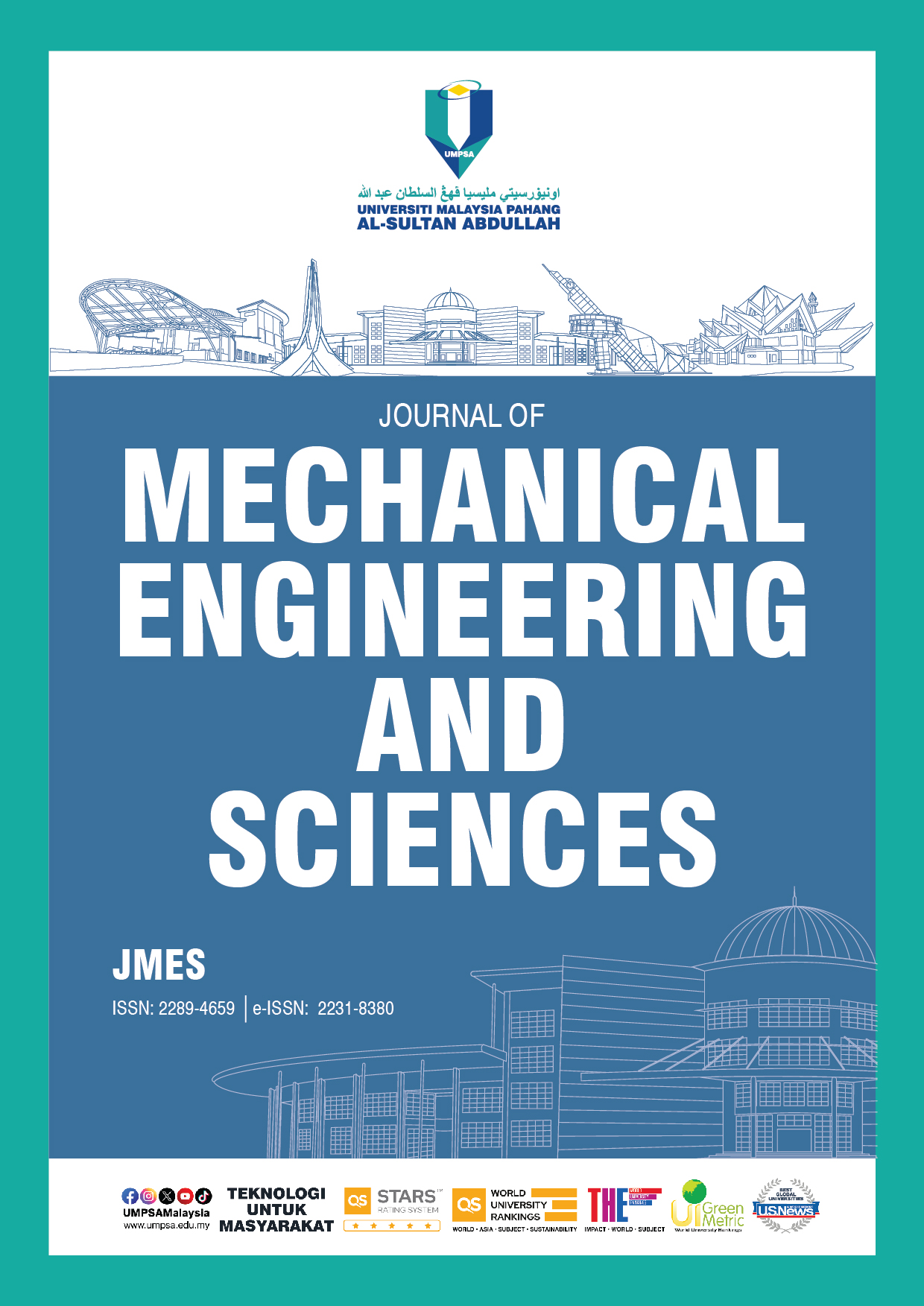Convection heat transfer of stepped basin single slope solar still: A numerical investigation
DOI:
https://doi.org/10.15282/jmes.17.2.2023.2.0746Keywords:
Solar still, Stepped basin, CFD, Fluid flow, Heat transfer analysisAbstract
Solar-powered desalination is a quick and easy way to make drinking water. Numerous solar distillation systems have been investigated for various parameter modifications based on local resource availability. In this work, a solar still with a modified stepped basin is investigated to raise the rate of internal evaporation and, therefore the output yield of the solar still. Stepped basin solar stills are taken into consideration for the study since they are very effective because the water's surface exposure to radiation is greater. Thus, increasing the rate of internal water evaporation enhances the rate of convective heat transfer between the evaporating and condensing surfaces, leading to improved and consistent output. The two-dimensional stepped basin single slope solar still was investigated and contrasted with the traditional single slope still in terms of heat transfer and fluid dynamics. To optimize the configuration for better performance in various types of climatic and operational circumstances that imitate the scenario of daily life, design elements such as the number of steps and the different heights of the basin are also taken into account. Each step was added with far more success than the one before it, up until the length was reduced to 1.16% of the entire shorter length. This numerical study enables us to draw the conclusion that the rise in natural heat transfer rate with the addition of steps is mostly caused by the increased surface area and the inherently restrictive nature within the domain. Additionally, with an increase in Rayleigh number, Ra, the gradient variations of the traditional single slope solar still overheat transfer features have been greatly regulated and successfully raised for the modified stepped basin Solar still.
References
K. Murugavel, K. Chockalingam, K. Srithar, “Progressesin improving the effectiveness of the single basin passive solar still,”Desalination, vol. 220, no. 1-3, pp. 677–686, 2008.
J. Torchia-Núñez, J. Cervantes-de-Gortari, M. Porta-Gándara, “Thermodynamics of a shallow solar still,”Energy and Power Engineering, vol. 6, pp. 246-265, 2014.
S. A. El-Agouz, Y.A.F. El-Samadony, A.E. Kabeel, “Performance evaluation of a continuous flow inclined solar still desalination system,”Energy Conversion Management, vol. 101, pp. 606-615, 2015.
S. Abdallah, M. M. Abu-Khader, O. Badran, “Effect of various absorbing materials on the thermal performance of solar stills,”Desalination, vol. 242, pp. 128-137, 2009.
T. Elango, K. Kalidasa Murugavel, “The effect of the water depth on the productivity for single anddouble basin double slope glass solar still,”Desalination, vol. 359, pp. 82-91, 2015.[6]V. Velmurugan, M. Gopalakrishnan, R. Raghu, K. Srithar, “Single basin solar still with fin for enhancing productivity,”Energy Conversion and Management, vol. 49, no. 10, pp. 2602-2608, 2008.
S. Rashidi, M. Bovand, J. Abolfazli Esfahani, “Optimization of partitioning inside a single slope solar still for performance improvement,”Desalination, vol. 395, pp. 79–91, 2016.
P. K. Srivastava, S.K. Agrawal, “Winter and summer performance of single sloped basin type solar still integrated with extended porous fins,”Desalination, vol. 319, pp. 73–78, 2013.
N. Rahbar, J.A. Esfahani, “Productivity estimation of a single-slope solar still: theoretical and numericalanalysis,”Energy, vol. 49, pp. 289–297, 2013.
A. J. Mohammed, “New design of stepped solar still,”Journal of Basrah Researchers(Sciences), vol. 39, no. 3, 2013.
A. Alaudeen, K. Johnson, P. Ganasundar, A. Syed Abuthahir, K. Srithar, “Study onstepped type basin in a solar still,”Journal of King Saud University–Engineering Science, vol. 26, no. 2, pp. 176-183, 2014,
M.D. Irfan Ali, R. Senthilkumar and R. Mahendren, “Modelling of solar still using granular activated carbon in MATLAB,”Bonfring International Journal of Power System Integrated Circuits, vol. 1, pp. 5–10, 2011.
S. Subhani, R. Senthil Kumar, “Numerical investigation on influence of mounting baffles in solar stills,”AIP Conference Proceedings, vol. 2161, p. 020025, 2019.
V. Velmurugana, K. Sritharb, “Solar stills integrated with a mini solar pond —analytical simulation and experimental validation,”Desalination, vol. 216, pp. 232–241, 2007.
V. Velmurugan, M. Gopalakrishnan, R. Raghu, K. Srithar, “Single basin solar still with fin for enhancing productivity,”Energy Conversion Management, vol. 49, pp. 2602–2608, 2008.
A. Jabbar, N. Khalifa, A. M. Hamood, “Performance correlations for basin type solar stills,”Desalination, vol. 249, pp. 24–28, 2009.
M. Feilizadeh, M. Soltanieh, K. Jafarpur, M.R. Karimi Estahbanati, “A new radiation model for a single-slope solar still,”Desalination, vol. 262, pp. 166–173, 2010.
T. Rajaseenivasan, K. Kalidasa Murugavel, “Theoretical and experimental investigation on double basin double slope solar still,”Desalination, vol. 319, pp. 25–32, 2013.
J. Xiong, G. Xie, H. Zheng, “Experimental and numerical study on a new multi-effect solar still with enhanced condensation surface,”Energy Conversion Management, vol. 73, pp. 176–185, 2013.
A. Rahmani, A. Boutriaa, A. Hadef, “An experimental approach to improve the basin type solar still using an integrated natural circulation loop,”Energy Conversion Management, vol. 93, pp. 298–308, 2015.
S. Rashidi, J. A. Esfahani, N. Rahbar, “Partitioning of solar still for performance recovery: Experimental and numerical investigations with cost analysis,”Solar Energy, vol. 153, pp. 41–50, 2017.
N. Rahbar, J.A. Esfahani, “Productivity estimation of a single-slope solar still: Theoretical and numerical analysis,”Energy, vol. 49, pp. 289-297, 2013.
S. Subhani, R. Senthil Kumar, “Numerical performance evaluation of tubular solar still with different geometries of water basin,”Desalination, vol. 196, pp. 360–369, 2020.
S. Subhani, R. Senthil Kumar, “Numerical investigation on modified solar still by mounting baffle,”Energy and Exergy for Sustainable and Clean Environment, vol. 1, pp. 43-59, 2022.
S. Subhani, R. Senthil Kumar, “Design and thermal performance analysis on solar still’, Lecture Notes in Mechanical Engineering,vol. 862, pp. 717-729, 2020.
Downloads
Published
Issue
Section
License
Copyright (c) 2023 Universiti Malaysia Pahang Publishing

This work is licensed under a Creative Commons Attribution-NonCommercial 4.0 International License.






